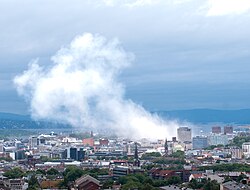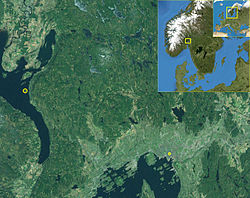
Back هجوما النرويج 2011 Arabic مدبحة النرويج 2011 ARZ Norveçdə terror aktları (2011) Azerbaijani 2011 m. Uosla atakas BAT-SMG Тэракты ў Нарвегіі (2011) Byelorussian Напады ў Нарвэгіі (2011) BE-X-OLD Атаки в Норвегия (2011) Bulgarian Napadi u Norveškoj 2011. BS Atemptats de Noruega de 2011 Catalan ھێرشەکانی نۆرویژ (٢٠١١) CKB
You can help expand this article with text translated from the corresponding article in Norwegian. (November 2023) Click [show] for important translation instructions.
|
| 2011 Norway attacks | |
|---|---|
 31 minutes after the explosion in Oslo | |
| Location | Oslo and Utøya, Norway |
| Coordinates | 59°54′55″N 10°44′46″E / 59.915184°N 10.746015°E (Regjeringkvartalet) 60°01′24″N 10°14′52″E / 60.023288°N 10.247704°E (Utøya island) |
| Date | 22 July 2011 (UTC+02:00) |
| Target | Labour Party members[4][5] |
Attack type | Car bombing, mass shooting, mass murder |
| Weapons |
|
| Deaths | 77 (8 by bombing, 67 by gunfire, 2 indirectly)[7][8] |
| Injured | 320+ (210+ by bombing, 32 by gunfire, 80+ indirectly)[9][10][11] |
| Trial | Trial of Anders Behring Breivik |
| Perpetrator | Anders Behring Breivik |
| Motive | |
| Verdict | Legally sane and guilty on both counts |
| Convictions | Committing a terrorist attack (2 counts) |
| Sentence | 21 years (subject to extension, minimum term of 10 years) |
| Part of a series on |
| Terrorism |
|---|
| Part of a series on |
| Neo-fascism |
|---|
 |
|
|
The 2011 Norway attacks, also called 22 July (Norwegian: 22. juli)[12] or 22/7 in Norway,[13] were two domestic terrorist attacks by far-right extremist Anders Behring Breivik against the government, the civilian population, and a Workers' Youth League (AUF) summer camp, in which a total of 77 people were killed.
The first attack was a car bomb explosion in Oslo within Regjeringskvartalet, the executive government quarter of Norway, at 15:25:22 (CEST).[1] The bomb was placed inside a van[14] next to the tower block housing the office of the then Prime Minister Jens Stoltenberg.[15] The explosion killed eight people and injured at least 209 people, 12 severely.[9][10][11]
The second attack occurred less than two hours later at a summer camp on the island of Utøya in Tyrifjorden, Buskerud. The camp was organised by the AUF, the youth wing of the ruling Norwegian Labour Party (AP). Breivik, dressed in a homemade police uniform and showing false identification,[16][17] took a ferry to the island and opened fire at the participants, killing 69[7][8][18] and injuring 32.[10][11] Among the dead were friends of Stoltenberg, and the stepbrother of Norway's crown princess Mette-Marit.[19] The Utøya attack is the deadliest mass shooting by a lone individual in modern history.
The attack was the deadliest in Norway since World War II.[20][21] A survey found that one in four Norwegians knew someone affected.[22] The European Union, NATO and several countries expressed their support for Norway and condemned the attacks. The 2012 Gjørv Report concluded that Norway's police could have prevented the bombing and caught Breivik faster at Utøya, and that measures to prevent further attacks and "mitigate adverse effects" should have been implemented.[23]
The Norwegian Police arrested Breivik, a 32-year-old Norwegian far-right extremist,[24] on Utøya island[25] and charged him with both attacks.[26] His trial took place between 16 April and 22 June 2012 in Oslo District Court, where Breivik admitted carrying out the attacks, but denied criminal guilt and claimed the defence of necessity (jus necessitatis).[27] On 24 August, Breivik was convicted as charged and sentenced to 21 years of preventive detention in prison with the possibility of indefinite five-year extensions for public safety, the maximum sentence allowed in Norway.
- ^ a b "Eksplosjonen i Oslo sentrum 22. juli 2011" [The explosion in Oslo 22 July 2011] (in Norwegian). 23 July 2011. Archived from the original on 28 March 2012. Retrieved 1 August 2011.
- ^ "Notat – Redgjørelse Stortinget" (PDF) (in Norwegian). Politiet. 10 November 2011. Archived from the original (PDF) on 15 December 2013. Retrieved 10 November 2011.
- ^ "Slik var Behring Breiviks bevegelser på Utøya". Aftenposten (in Norwegian). 16 April 2012. Retrieved 16 April 2012.
- ^ "Norway: Anders Behring Breivik claims 'two more cells'". BBC News. 25 July 2011.
- ^ "Arbeiderpartiet har sveket landet, og prisen fikk de betale fredag" [The Labour Party has betrayed the country, and the price they paid on Friday]. NRK (in Norwegian). 25 July 2011.
- ^ "Skutt på kloss hold" [Shot at close range]. Dagsavisen (in Norwegian). 3 May 2012. Archived from the original on 17 May 2012.
- ^ a b "Terrorofrene på Utøya og i Oslo". Verdens Gang (in Norwegian). Schibsted ASA. Archived from the original on 9 September 2011. Retrieved 29 July 2011.
- ^ a b "Navn på alle terrorofre offentliggjort". Verdens Gang (in Norwegian). Schibsted ASA. 29 July 2011. Archived from the original on 23 November 2011. Retrieved 27 September 2011.
- ^ a b "Dette er Breivik tiltalt for" [Breivik's indictment] (in Norwegian). NRK. 7 March 2012.
- ^ a b c "Oslo government district bombing and Utøya island shooting July 22, 2011: The immediate prehospital emergency medical service response". Scandinavian Journal of Trauma, Resuscitation and Emergency Medicine. 26 January 2012.
- ^ a b c "Læring for bedre beredskap; Helseinnsatsen etter terrorhendelsene 22. juli 2011" (in Norwegian). 9 March 2012. Archived from the original on 29 October 2013.
- ^ "Journalists and PTSD: Is it about guilt?". Columbia Journalism Review. 6 December 2013.
- ^ "Må i retten for underslag av 22/7-penger". Verdens Gang. 26 November 2016. Retrieved 15 December 2016.
- ^ "Her er restene av bombebilen" [Here is the remains of the car]. NRK (in Norwegian). 29 October 2011.
- ^ "Ble sett av ti kameraer" [Was seen by ten surveillance cameras]. ABC Nyheter (in Norwegian). 16 September 2011. Archived from the original on 11 December 2011.
- ^ "Slik skaffet han politiuniformen" [How he obtained the uniform]. NRK (in Norwegian). 24 July 2011.
- ^ "Slik var Behring Breivik kledd for å drepe" [How Behring Breivik was dressed to kill]. Dagbladet (in Norwegian). 20 November 2011.
- ^ "En av de sårede døde på sykehuset" [One of the wounded died in hospital]. Østlendingen (in Norwegian). 24 July 2011. Retrieved 25 July 2011.
- ^ Sanchez, Raf (25 July 2011). "Norway killings: Princess's brother Trond Berntsen among dead". The Daily Telegraph. London. Archived from the original on 12 January 2022.
- ^ "Prime minister: Norway still 'an open society' despite 'the horror'". CNN. 25 July 2011.[dead link]
- ^ "Tre timer som forandret Norge" [Three hours that changed Norway]. Stavanger Aftenblad (in Norwegian). 28 December 2011. Archived from the original on 31 March 2016. Retrieved 28 January 2012.
- ^ "1 av 4 kjenner rammede" [1 of 4 know a victim]. Klassekampen (in Norwegian). 19 August 2011.
- ^ "Norway police 'could have stopped Breivik sooner'". BBC News Europe. 13 August 2012. Retrieved 1 September 2012.
- ^ "Man held after Norway attacks right-wing extremist: report". Reuters. 22 July 2011. Retrieved 22 July 2011.
- ^ Rayner, Gordon (27 July 2011). "Norway shootings: Anders Behring Breivik surrendered with his hands above his head". The Telegraph. London. Archived from the original on 12 January 2022.
- ^ "Norway suspect Anders Behring Breivik 'admits attacks'". BBC. 24 July 2011.
- ^ "Norwegians value respecting killer's human rights". CNN. 17 April 2011.
